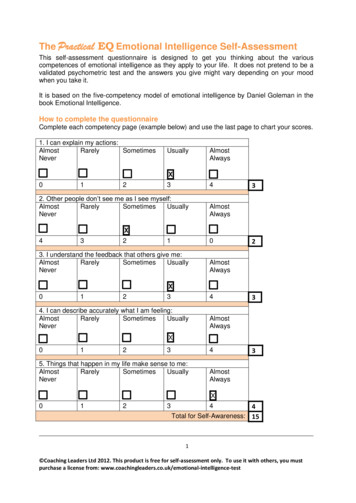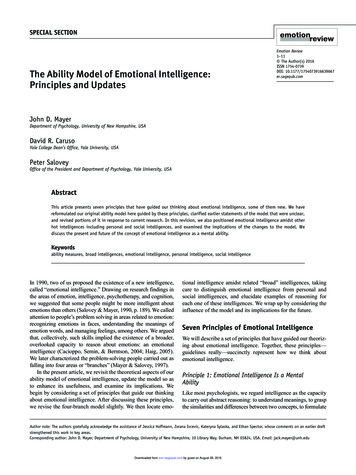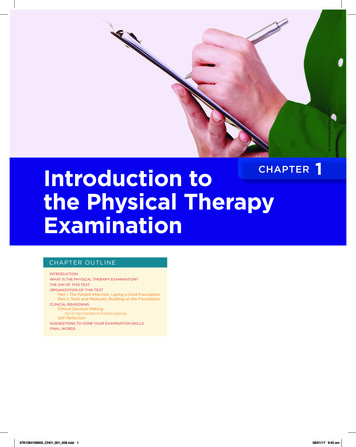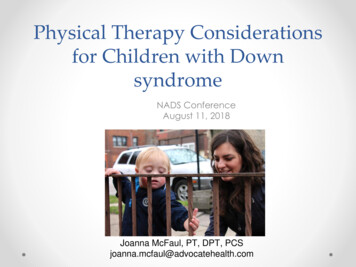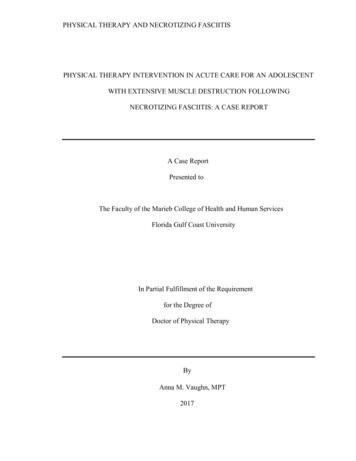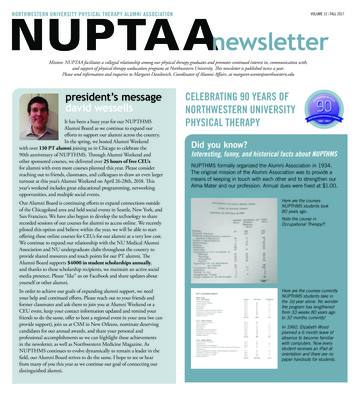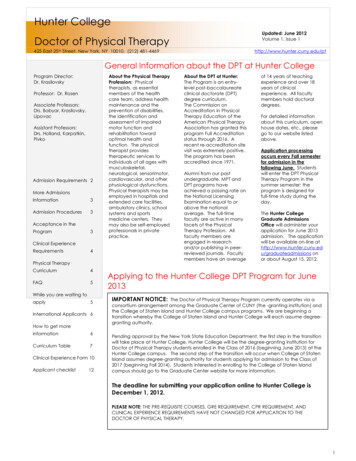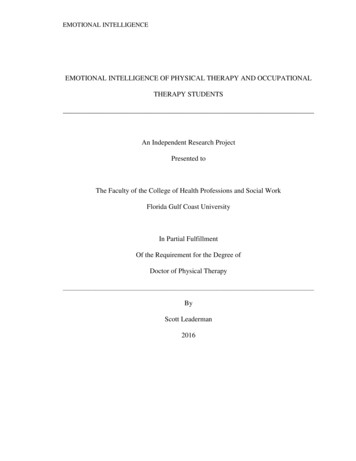
Transcription
EMOTIONAL INTELLIGENCEEMOTIONAL INTELLIGENCE OF PHYSICAL THERAPY AND OCCUPATIONALTHERAPY STUDENTSAn Independent Research ProjectPresented toThe Faculty of the College of Health Professions and Social WorkFlorida Gulf Coast UniversityIn Partial FulfillmentOf the Requirement for the Degree ofDoctor of Physical TherapyByScott Leaderman2016
EMOTIONAL INTELLIGENCEAPPROVAL SHEETThis Independent Research Projectis submitted in partial fulfillment of the requirements forthe degree ofDoctor of Physical TherapyScott LeadermanApproved: April 2016Arie van Duijn, EdD, PT, OCSCommittee ChairEric Shamus, PhD, DPT, CSCSCommittee MemberThe final copy of this independent research project has been examined by the signatories, and we find that both the content and theform meet acceptable presentation standards of scholarly work in the above mentioned discipline.
EMOTIONAL INTELLIGENCEAcknowledgementsI would like to thank those who were instrumental in the support, development,and completion of my research project. To my committee members: Thank you Dr. Arievan Duijn for allowing me to build off of my interest of understanding how we canfurther our ability to educate and interact with patients in a more positive manner and forconstructing the concept of analyzing the emotional intelligence of students in the PTprogram. Thank you for becoming my scholarly role model and someone I can alwaysturn to in the past and in the future. Thank you Dr. Eric Shamus for supporting myendeavor and for facilitating the OT students as part of the study. To my Florida GulfCoast University classmates, thank you for participating in the study. Without yourwillingness to take time of your day to answer my survey, the research project couldnever have come to fruition. And finally to my parents, brother, and family, I would liketo thank you for always believing in me and supporting me in whatever I wanted toaccomplish.
EMOTIONAL INTELLIGENCE4Table of ContentsAbstract .6Introduction .8Indications of person with high EI .9Purpose .9Research Questions 10Literature Review .10Patient Provider Relationship .11EI and medical curriculum .12Bar-On Model of Emotional Intelligence . 13Mental Ability Model .13Four Branch Ability Model 14Framework Studies . 15Methods .17Research Design .17Instrumentation . 17Sampling Strategy .17Exclusion Criteria .18Data Collection Process . 18Data Analysis . 19Results 19Discussion . 32Variables of interest. . 32
EMOTIONAL INTELLIGENCERelationship between PT, OT and EIQ .533Limitations of study 34Conclusion . 35Recommendations for future research 35References .36
EMOTIONAL INTELLIGENCE6AbstractIntroduction. The purpose of this research study was to examine the emotionalintelligence (EI) of Florida Gulf Coast University (FGCU) Doctor of Physical Therapy(DPT) and Masters of Occupational Therapy (MOT) students and to compare their scoresto normative data of the general population.Methods. The students were given a validated test called the Mayer-SaloveyCaruso Emotional Intelligence Test on-line. After completion of the testing sessions, thedata was compared between subject groups and to the normative scores.Data Analysis. The researcher examined the scores by using descriptive statisticsof the data in order to determine if the scores were similar to those found by the previousstudy of practicing physical therapists as well as to compare the scores to the generalpopulation. A t-Test was also used to determine if there was a statistical significancebetween the DPT and MOT groups.Results. When compared to the normative 18-24 year-old scores, the DPT andMOT cohorts of the 18-24 year old age range scored higher in total EIQ as well as allbranch scores than the normative values, but the older participants scored near thenormative mean in total EIQ and on branch scores. The male participant mean for boththe DPT and MOT groups was higher in total EIQ compared to males of all age groups inthe general mean, whereas the female mean was lower than the female normative mean.Descriptive statistics reveal that female participants scored higher in total EIQ than themale participants. There was no statistically significant difference between the total EIQscores of DPT and MOT program students at FGCU.
EMOTIONAL INTELLIGENCE7Conclusion. First year DPT and MOT program students had higher MSCEITscore than their age-matched peers. There are several hypotheses for why the participantsscored higher on the MSCEIT than the age-matched general population in the context oftheir chosen career paths. In the rehabilitation science profession, it is important to beable to encourage patients to leave their comfort zone in order to overcome limitations.While it is vital to have empathy and understand a patient from an emotional standpoint,the key construct of rehabilitation medicine requires an individual who is able to controltheir emotions and the emotional output of patients in order to be able to successfullypush the patient to achieve their goals without sacrificing patient satisfaction and qualityof care. Future research in needed to determine if EI is an attribute that is innate to thosewho seek a career in health professions, and to determine if EI testing may have a role inselecting students for Physical Therapy and Occupational Therapy programs.
EMOTIONAL INTELLIGENCE8IntroductionThe patient-provider relationship is important for the effective treatment ofpatients. In a time where there is fierce competition by other healthcare providers forpatient trust, loyalty, and satisfaction, those healthcare practitioners who are morecognizant of their patient’s emotions have a better chance of treating them successfully(Weng, Chen, Chen, Lu, & Hung, 2008). The patient-provider relationship is only able tocontinue when the patient trusts that in return for their time and money, they are morelikely to recover from their illness (Weng et al.). Emotional Intelligence (EI) is used todescribe the level a practitioner is not only aware of their patient’s emotional needs, butalso understands how to properly act on those emotions.The theory of emotional intelligence has involved since its inception. In 1930,Robert Thorndike stated that there were three different types of intelligence. The threeintelligences he named were abstract, mechanical, and social intelligence (Kinchole,2004). The term EI was first coined in 1997 by Mayer and Salovey. They defined EI as“the capacity to reason about emotions, and of emotions to enhance thinking. It includesthe abilities to accurately perceive emotions, to discriminate among them, and generateemotions so as to assist thought, to understand emotions and emotional knowledge, andto reflectively regulate emotions so as to promote emotional and intellectual growth”(Mayer & Salovey, 1997). Ultimately, EI is linked to the successful integration andcombination of both intelligence and emotion. Mayer further subdivides intelligence, inwhich emotional intelligence falls under the category of hot intelligences such as socialintelligence, practical intelligence, and personal intelligence indicating that theseintelligences are the most important in thoughts that are dealing with matters of personal
EMOTIONAL INTELLIGENCE9and emotional importance to the individual (Mayer & Mitchell, 1998). Emotions areclassed into three fundamental classes of mental operations which are emotion, cognition,and motivation (Sternberg, 2000). Sternberg writes that basic motivations come forth asa result of internal bodily states and drives such as basic needs, they are highlypredictable, and they end after a stimulus has been introduced such as you drink water toquench your thirst. Emotions are thought to have evolved within mammals to signal andrespond to changes in the relationship between individuals and others and theirenvironment. Cognition allows the individual to learn from their environment and to beable to integrate that knowledge to problem-solve in situations that are new to them(Sternberg).Indications of a person with high EIThis person can better perceive emotions, use them in thought, understand theirmeanings, and effectively manage their own emotions. They are more likely to havehigher levels of verbal and social intelligences as well. They are more likely to choosecareers in areas that involve high levels of interpersonal interaction. High EI individualsare less likely to engage in problematic behaviors such as drug abuse, drinking, violence,smoking, and excessive drinking. Finally, they are more likely to have positivesentimental attachments to others (Mayer & Mitchell, 1998).PurposeThe primary purpose of the study was to describe the level of EmotionalIntelligence (EI) of Doctor of Physical Therapy students (DPT) and Master ofOccupational Therapy (MOT) students at Florida Gulf Coast University (FGCU) asmeasured by the Mayer-Salovey-Caruso Emotional Intelligence Test (MSCEIT).
EMOTIONAL INTELLIGENCE10Research QuestionsThis study was conducted to answer the following research questions:o Research Question 1: What is the level of Emotional Intelligence of DPTstudents at FGCU as measured by the MSCEIT?o Research Question 2: What is the level of EI of MOT students at FGCUas measured by the MSCEIT?o Research Question 3: How does the EI of DPT and MOT studentscompare to the normative values of the general population?o Research Question 4: Is there a difference in the level of EI between OTand PT students?Literature ReviewEI is different than other forms of intelligence and understanding. There areseveral key differences between EI and verbal language processing. The first differenceis other species have forms of language, but that the process of understanding emotionalinformation is unique to mammals (Mayer et al., 2001). The second difference is thatverbal information processing is very direct, whereas emotional information processing isvery indirect and it involves a deeper understanding of relationships among people. Thethird difference is that while verbal-propositional intelligence is taught in an institutionalfashion amongst all people, emotional intelligence is not taught in in an institutionalizedmanner, making it more elusive and difficult to attain as compared to intelligence ofverbal processing (Mayer et al.).
EMOTIONAL INTELLIGENCE11The Patient-Provider RelationshipAlthough very few studies have been conducted on the emotional intelligence ofDPT students, there has been research done about the EI of other healthcare providers.One study in 2008 studied the relationship between patient trust in their medical doctorand the emotional intelligence of the medical doctor. In the study, the researchers gave994 patients an 11-item trust scale questionnaire to rate patient satisfaction of theirdoctors and they gave 39 medical doctors a 16 item EI survey based off of the Wong andLaw Emotional Intelligence Scale (Weng et al., 2008). The results of the EI and patientssurvey indicated a positive correlation between patient trust and the level of EI of thedoctor, and the older and less educated the patient was, the greater the trust in the doctor.There are several limitations noted in the study. Firstly, there was selection bias becausethose healthcare practitioners who agreed to participate in the study were also likely to bevery emotionally intelligent and skillful practitioners. The small sample size ofpotentially biased doctors could also make it hard to determine if the study can begeneralized to the rest of the medical doctors. It is also likely that the patient participantsin the study both had good feelings towards their doctors and they also would likely feelas though the patient-provider relationship is of high importance, thus making them wantto participate in the study and give their input (Weng et al.).A similar study in 2011 tried to describe associations between EI, job satisfaction,patient satisfaction, and the burnout rate for medical doctors (Weng et al., 2011). In thisstudy, the researchers conducted 2,982 face to face interviews with 110 medical doctorsand 2872 patients. Medical doctor’s EI was measured by the Wong and Law EmotionalIntelligence Scale (WLEIS), doctor burnout was measured by the Maslach Burnout
EMOTIONAL INTELLIGENCE12Inventory (MBI), and patient satisfaction was measured on a Likert scale after the patientwas given verbal prompting in the form of a question. Unlike the previous study, thisstudy found that the doctor’s level of EI was not significantly correlated to patientsatisfaction, however, the higher EI was correlated with lower instances of doctor burnoutand higher rates of job satisfaction among the physicians studied (Weng et al.).EI and medical curriculumIn 2011, a study was conducted to determine if EI was being taught in thecurriculum for Obstetricians and Gynecologists (OG) in England, as all universities arerequired to follow the same curriculum (Pilkington, Hart, & Bundy, 2011). In the study,16 OGs who did not have backgrounds in psychology were asked to review between oneand three of the teaching modules currently being used in medical schools. Participantswere asked to denote the number of occurrences of a list of words that the researchersdeemed as being important to the concept of EI. The words were also broken down intocategories. Under the intra-personal category they used the words self-regard, emotionalself-awareness, assertiveness, independence, and self-actualization. Under the stressmanagement category the researchers listed the words stress, tolerance and impulsecontrol. The adaptability category contained the terms reality testing, feasibility, problemsolving, and the general mood category contained the terms optimism and happiness.After reviewing of the teaching modules, the concept of empty was found to be the mostcommonly used EI term in the curriculum, but the ideas of social responsibility or interpersonal relationships were not explicitly mentioned within the curriculum. This studyshows that while the concept of empathy is widely used within the curriculum, thedoctors are not being taught how to properly manage interpersonal relationships, which
EMOTIONAL INTELLIGENCE13could ultimately lead to less patient satisfaction and poorer patient outcome. Althoughthis is not linked directly to physical therapy, this study does point out the shortfalls ofother health profession curriculums. There are several different proposed models ofemotional intelligence (Pilkington, Hart, & Bundy).Bar-on Model of Emotional IntelligenceIn 1997, Reuven-Bar-on developed a test to measure the Emotional Quotient ofindividuals. This model is used to describe the potential that an individual has to beemotionally intelligent rather than their current emotional intelligence, making the testprocess-oriented in nature. The overall definition of this model is that “Emotionalintelligence is an array of noncognitive capabilities, competencies, and skills thatinfluence one’s ability to succeed in coping with environmental demands and pressure(Bar-On, 1997). The aim of this model is to examine how an individual will interactand apply his or her information, skills, and experience to a given situation. The majorareas that this model focuses on are Intrapersonal skills, such as emotional awareness,assertiveness, self-regard, and independence, Interpersonal skills such as empathy,Adaptability skills such as problem solving and flexibility, Stress management skills, andgeneral mood (Bar-On).Mental Ability ModelThe mental ability model of EI describes an individual’s internal structure ofintelligence and emotions and the implications that that structure has on their live. Themodel stats that emotional intelligence is like other intelligences and will adapt to meetthree empirical criteria. These criteria are that mental problems have a right or wronganswer, measured EI skills correlate with other mental ability scores as they are all
EMOTIONAL INTELLIGENCE14related, and the ability to be emotional intelligent increase with age. This model statesthat emotionally intelligence people are likely to be able to effectively reframe emotions,grew up in a household with emotionally sensitive parents, are more likely to be nondefensive, choose good role models, are good at communicating and discussing feelings,and develop expert knowledge in one particular emotional area (Sternberg, 2000).Four Branch Ability ModelThe EI model that this study will employ is the four-branch ability model createdby Mayer and Salovey in 1997. This model divides EI into four primary abilities whichare the ability to perceive emotion, use emotions to help facilitate thoughts, understandemotions, and mange emotions (Mayer & Salovey, 1997). Branch one, or the ability toperceive emotion (PEIQ), involves the capacity to recognize emotion in the posturalexpression, facial expression, and tone of voice in both himself and in others (Mayer &Mitchell, 1998). This branch also is linked to the ability of an individual to distinguishbetween genuine and ingenuine expressions of feelings (Mayer & Salovey). Branch two,or the ability to use emotions to help facilitate thoughts (FEIQ) involves the ability to useemotions to assist in thinking and information processes (Mayer & Mitchell, 1998). Inorder to be successful in the skills of this branch, a life-long knowledge base must becreated and stored in the memory of the individual that they can draw on and help themin other situations. Branch three is related to the ability to understand, analyze, andappreciate emotions (UIEQ) and understand the outcomes of each emotion both shortterm and over an extended period of time. Branch four is related to the management ofemotions (MEIQ) and the effect that emotions have on an individual’s goals, selfknowledge, and social awareness. This branch is focused on the ability to manage
EMOTIONAL INTELLIGENCE15emotions in both the life of the individual and the lives of others that the individual maycome in contact with (Mayer & Mitchell).There are two areas defined by Mayer that supersede the branches. The first areais Experiential Intelligence (EEIQ) (Mayer, Salovey, & Caruso, 2004). This areadescribes a person’s ability to perceive emotional information and to integrate it intopreviously experienced data in order to facilitate thought. This means that individualswith high EI are able to take emotions that they experience and match them together withspecial senses such as taste, color, temperature, and smell in order to better code the datain the brain. The second area is Strategic Emotional Intelligence (SEIQ). This areadescribes a person’s ability to understand emotional input and use emotions to better plantheir actions (Mayer, Salovey, & Caruso).Framework StudiesTwo studies provide the framework for this research project. One study was across sectional survey of the EI and empathy of medical school students of the FatinaMemorial College of Medicine and King Edward Medical University in Pakistan. Theysurveyed first year and final year MD students. The tool they used to survey the studentswas the Schutte Emotional Intelligence Scale which is a 33 question test with answersthat take on the properties of the Likert scale. The test is designed to measure theparticipant’s ability to apprised and express emotion, the ability to regulate
intelligence (EI) of Florida Gulf Coast University (FGCU) Doctor of Physical Therapy (DPT) and Masters of Occupational Therapy (MOT) students and to compare their scores to normative data of the general population. Methods. The students were given a validated test called the


